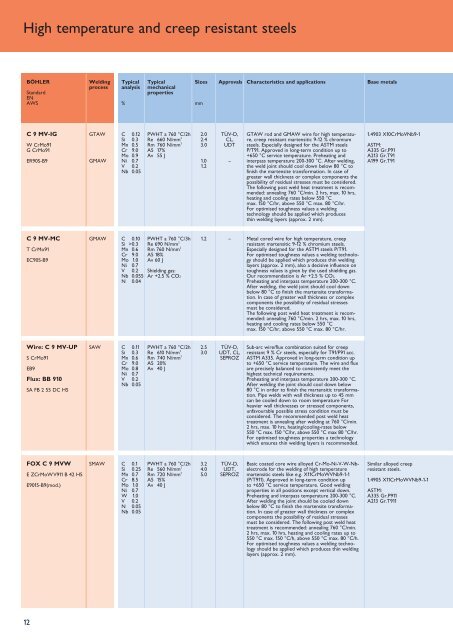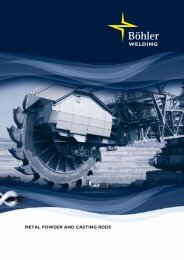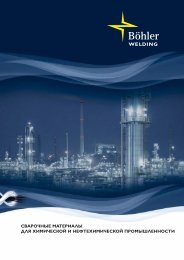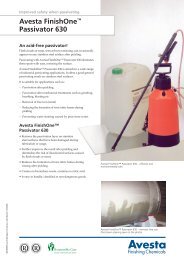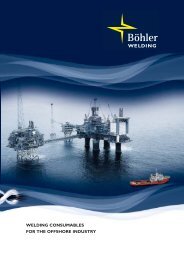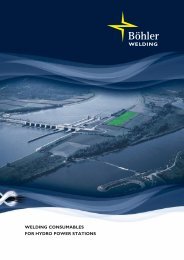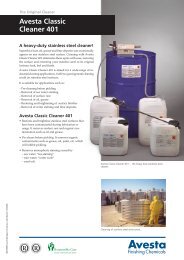WELDING Consumables for thermal power stations
WELDING Consumables for thermal power stations
WELDING Consumables for thermal power stations
You also want an ePaper? Increase the reach of your titles
YUMPU automatically turns print PDFs into web optimized ePapers that Google loves.
High temperature and creep resistant steels<br />
BÖHLER<br />
Standard<br />
EN<br />
AWS<br />
Welding<br />
process<br />
Typical<br />
analysis<br />
%<br />
Typical<br />
mechanical<br />
properties<br />
Sizes<br />
mm<br />
Approvals<br />
Characteristics and applications<br />
Base metals<br />
C 9 MV-IG<br />
W CrMo91<br />
G CrMo91<br />
ER90S-B9<br />
GTAW<br />
GMAW<br />
C 0.12<br />
Si 0.3<br />
Mn 0.5<br />
Cr 9.0<br />
Mo 0.9<br />
Ni 0.7<br />
V 0.2<br />
Nb 0.05<br />
PWHT a 760 °C/2h<br />
Re 660 N/mm 2<br />
Rm 760 N/mm 2<br />
A5 17%<br />
Av 55 J<br />
2.0<br />
2.4<br />
3.0<br />
1.0<br />
1.2<br />
TÜV-D,<br />
CL,<br />
UDT<br />
–<br />
GTAW rod and GMAW wire <strong>for</strong> high temperature,<br />
creep resistant martensitic 9-12 % chromium<br />
steels. Especially designed <strong>for</strong> the ASTM steels<br />
P/T91. Approved in long-term condition up to<br />
+650 °C service temperature. Preheating and<br />
interpass temperature 200-300 °C. After welding,<br />
the weld joint should cool down below 80 °C to<br />
finish the martensite trans<strong>for</strong>mation. In case of<br />
greater wall thickness or complex components the<br />
possibility of residual stresses must be considered.<br />
The following post weld heat treatment is recommended:<br />
annealing 760 °C/min. 2 hrs, max. 10 hrs,<br />
heating and cooling rates below 550 °C<br />
max. 150 °C/hr, above 550 °C max. 80 °C/hr.<br />
For optimised toughness values a welding<br />
technology should be applied which produces<br />
thin welding layers (approx. 2 mm).<br />
1.4903 X10CrMoVNb9-1<br />
ASTM:<br />
A335 Gr.P91<br />
A213 Gr.T91<br />
A199 Gr.T91<br />
C 9 MV-MC<br />
T CrMo91<br />
EC90S-B9<br />
GMAW C 0.10<br />
Si >0.3<br />
Mn 0.6<br />
Cr 9.0<br />
Mo 1.0<br />
Ni 0.7<br />
V 0.2<br />
Nb 0.055<br />
N 0.04<br />
PWHT a 760 °C/3h<br />
Re 690 N/mm 2<br />
Rm 760 N/mm 2<br />
A5 18%<br />
Av 60 J<br />
Shielding gas:<br />
Ar +2.5 % CO2<br />
1.2 – Metal cored wire <strong>for</strong> high temperature, creep<br />
resistant martensitic 9-12 % chromium steels.<br />
Especially designed <strong>for</strong> the ASTM steels P/T91.<br />
For optimised toughness values a welding technology<br />
should be applied which produces thin welding<br />
layers (approx. 2 mm), also a decisive influence on<br />
toughness values is given by the used shielding gas.<br />
Our recommendation is Ar +2.5 % CO2.<br />
Preheating and interpass temperature 200-300 °C.<br />
After welding, the weld joint should cool down<br />
below 80 °C to finish the martensite trans<strong>for</strong>mation.<br />
In case of greater wall thickness or complex<br />
components the possibility of residual stresses<br />
must be considered.<br />
The following post weld heat treatment is recommended:<br />
annealing 760 °C/min. 2 hrs, max. 10 hrs,<br />
heating and cooling rates below 550 °C<br />
max. 150 °C/hr, above 550 °C max. 80 °C/hr.<br />
Wire: C 9 MV-UP<br />
S CrMo91<br />
EB9<br />
Flux: BB 910<br />
SA FB 2 55 DC H5<br />
SAW C 0.11<br />
Si 0.3<br />
Mn 0.6<br />
Cr 9.0<br />
Mo 0.8<br />
Ni 0.7<br />
V 0.2<br />
Nb 0.05<br />
PWHT a 760 °C/2h<br />
Re 610 N/mm 2<br />
Rm 740 N/mm 2<br />
A5 20%<br />
Av 40 J<br />
2.5<br />
3.0<br />
TÜV-D,<br />
UDT, CL,<br />
SEPROZ<br />
Sub-arc wire/flux combination suited <strong>for</strong> creep<br />
resistant 9 % Cr steels, especially <strong>for</strong> T91/P91 acc.<br />
ASTM A335. Approved in long-term condition up<br />
to +650 °C service temperature. The wire and flux<br />
are precisely balanced to consistently meet the<br />
highest technical requirements.<br />
Preheating and interpass temperature 200-300 °C.<br />
After welding the joint should cool down below<br />
80 °C in order to finish the martensitic trans<strong>for</strong>mation.<br />
Pipe welds with wall thickness up to 45 mm<br />
can be cooled down to room temperature For<br />
heavier wall thicknesses or stressed components,<br />
unfavourable possible stress condition must be<br />
considered. The recommended post weld heat<br />
treatment is annealing after welding at 760 °C/min.<br />
2 hrs, max. 10 hrs, heating/cooling-rates below<br />
550 °C max. 150 °C/hr, above 550 °C max 80 °C/hr.<br />
For optimised toughness properties a technology<br />
which ensures thin welding layers is recommended.<br />
FOX C 9 MVW<br />
E ZCrMoWV911 B 42 H5<br />
E9015-B9(mod.)<br />
SMAW C 0.1<br />
Si 0.25<br />
Mn 0.7<br />
Cr 8.5<br />
Mo 1.0<br />
Ni 0.7<br />
W 1.0<br />
V 0.2<br />
N 0.05<br />
Nb 0.05<br />
PWHT a 760 °C/2h<br />
Re 560 N/mm 2<br />
Rm 720 N/mm 2<br />
A5 15%<br />
Av 40 J<br />
3.2<br />
4.0<br />
5.0<br />
TÜV-D,<br />
UDT,<br />
SEPROZ<br />
Basic coated core wire alloyed Cr-Mo-Ni-V-W-Nbelectrode<br />
<strong>for</strong> the welding of high temperature<br />
martensitic steels like e.g. X11CrMoWVNb9-1-1<br />
(P/T911). Approved in long-term condition up<br />
to +650 °C service temperature. Good welding<br />
properties in all positions except vertical down.<br />
Preheating and interpass temperature 200-300 °C.<br />
After welding the joint should be cooled down<br />
below 80 °C to finish the martensite trans<strong>for</strong>mation.<br />
In case of greater wall thickness or complex<br />
components the possibility of residual stresses<br />
must be considered. The following post weld heat<br />
treatment is recommended: annealing 760 °C/min.<br />
2 hrs, max. 10 hrs, heating and cooling rates up to<br />
550 °C max. 150 °C/h, above 550 °C max. 80 °C/h.<br />
For optimised toughness values a welding technology<br />
should be applied which produces thin welding<br />
layers (approx. 2 mm).<br />
Similar alloyed creep<br />
resistant steels.<br />
1.4905 X11CrMoWVNb9-1-1<br />
ASTM:<br />
A335 Gr.P911<br />
A213 Gr.T911<br />
12


